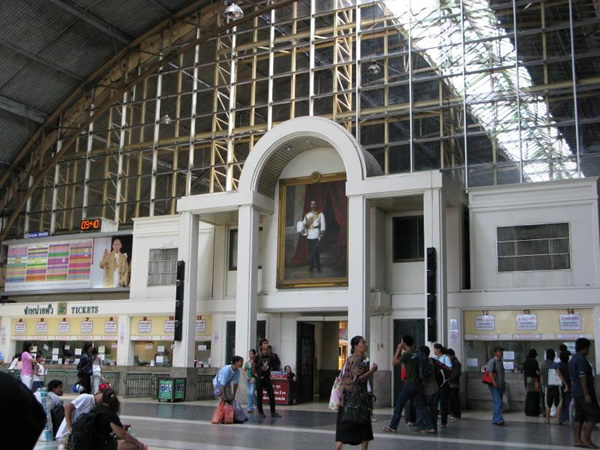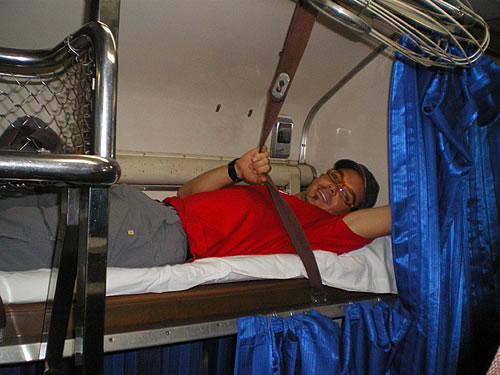Guide to Cheap Train Travel in Southeast Asia
Bangkok is a Hub
Story and photos by Nora Dunn

|
|
Bangkok is the hub for Southeast Asian train travel, which is a cheap way to explore much of Asia.
|
Traveling by train through Southeast Asia is safe, incredibly cheap, efficient, relatively environmentally-friendly, and a much better way to get a sense of what a country is like than you would ever get by flying. The budget-conscious may prefer to take a bus instead, but you would be surprised at the lack of correlation between comfort, time, and cost when it comes to comparing trains and buses. In this article you will find the information you need to plan your own overland train trip through Southeast Asia.
Starting in Bangkok
After being overwhelmed by Bangkok’s sights and smells, I hopped on an overnight train to Chiang Mai to escape the chaos. I was pleasantly surprised by a number of things: the ease of purchasing tickets and finding the correct train to board, the comfort of even the second class berths, and the overall efficiency of the trip. I arrived in Chiang Mai the following morning, fresh after a decent sleep and enthusiastic after a number of conversations with fellow passengers who were local to the area.
Trains versus Planes
The cost of short-haul flights in Southeast Asia is a relative pittance. For approximately US$60, I could have boarded a plane in Bangkok and arrived in Chiang Mai after just over an hour of flight time. However, once you factor in the time and cost of transportation to and from airports, as well as make time allowances for check-in and security, taking a plane for a short-haul flight loses its luster; a 1-hour flight becomes a 3 to 5-hour ordeal. There is also no getting around the negative environmental impact of air travel, which is largely unnecessary for shorter trips. And I am not sure if this is the case with others, but plane travel wreaks havoc with my body too; it is just not a natural thing to do.
Trains versus Buses
Many cost-conscious travelers (and some locals) flock to buses as their preferred method of travel. For approximately US$15, the twelve hour ride is a pretty good deal. If you choose an air-conditioned bus (which most travelers do), you should have a relatively comfortable experience, often with videos available and sometimes even drinks and snacks for sale.
However, sometimes cost is not the be-all and end-all – even for locals who are arguably on a tighter budget than many travelers. A Thai friend of mine made the journey from Chiang Mai to Bangkok for business shortly after we met. He took the overnight bus down to Bangkok, only to fret through a sleepless night of while being in the company of a noisy group, and having the lady in front of him recline her seat fully and directly into his lap. Upon his return, he happily paid the full train fare for his trip back to Chiang Mai (despite having already paid for a return bus ticket) – and felt much more refreshed for it.
Travelers too can have a rough go of it when taking the bus. After barely surviving their own bus ride from Bangkok to Chiang Mai, two German travelers I met decided to continue on their bus journey through Thailand and other parts of Southeast Asia as well. However, they too were won over by the convenience and comfort of the train after more than a few sleepless nights with rowdy passengers and sore backs from sitting upright all night.
The Local Choice
As my Thai and German friends decided, the train is the most economical and comfortable option for Southeast Asian travel. This is evidenced by the number of local Asians you will see when you take the train yourself. For the same journey from Bangkok to Chiang Mai that costs US$15-60 dollars to ride the bus or fly, you will pay approximately US$20 to take the train.
I have sharpened and expanded my knowledge of local Asian languages on the train, talked about civil engineering with a Malaysian fellow, shared breakfast with a beautiful Thai grandmother, and even chatted and played cards with a young Singaporean couple who invited me to stay with them.
The Overnight Train
Many popular routes feature an express or overnight fare. For the same US$20 I spent to take the train from Bangkok to Chiang Mai, I also received a “free” night of accommodation – on the train. The seats conveniently fold down into a lower berth, and an upper berth flips out from the ceiling. Many people find the constant motion of the train to be conducive for a decent night of sleep. At the very least, the opportunity to get horizontal (unlike the bus) is worthwhile.
Then again, the overnight train experience bypasses much of the scenery that you might want to see. Between Bangkok and Chiang Mai, for example, there are miles upon miles of beautiful jungle and stunning landscapes. One of the unique benefits of overland travel is the ability to see and gain an understanding of the size and grandeur of a country; something that air travel misses out on entirely. So in researching your desired route, you may want to determine which legs of the journey you want to be awake for in order not to miss some great opportunities for sites and pictures.

|
|
The upper berth on most overnight trains folds out from the ceiling for a chance to get horizontal for the night.
|
Long-Haul and Inter-Country Southeast Asian Train Travel
Thus far I have concentrated on the Bangkok to Chiang Mai train fare as a way to compare various methods of travel in Southeast Asia. But there is so much more to Southeast Asia’s railways than this popular route. New routes have just been established between Thailand and Laos, and well-established rail lines also exist in (and between) Cambodia, Vietnam, China, India, Malaysia, Singapore, and other Asian countries.
Please note that the amenities and quality of the trains is very much dependent on the line, the country, and the popularity of the route. Some “sleeper class” trains are really just hammocks strung up in an empty box-car. Your “air conditioned first class” ticket might be a pass to a derelict car with uncomfortable wooden seats and missing windows. Then again, all budget travel in Asia is generally an exercise in surprises and compromises with regard to comfort in the name of experiencing a new culture and land; it is part of the adventure
.
Southeast Asian Train Travel Tips
Having traveled through a number of Southeast Asian countries by train, here are a few tips to help you make the most of your own rail journey:
-
Bring food and drinks. Although some trains serve meals and drinks in a dining car, and others yet have dedicated servers who peddle food and drinks while walking through the cars, the quality and quantity of such refreshments is not to be counted on. (I nearly starved on my trip through Malaysia.)
-
Keep an eye on your bags. For the most part train travel is safe and the people friendly, but a good dose of street sense is still required. Foreigners are easy targets throughout much of Southeast Asia, so don’t wander too far from your valuables without securing them.
-
Allow extra time to arrive. Trains are not renowned for being on time in many places around the world, and Southeast Asia is no exception. Do not make any immediate plans for your arrival, just in case you are late. The longer the journey, the better the chance is that you will step off the train minutes to hours after your scheduled arrival.
-
Be prepared for an arresting toilet experience. If there is even a toilet available, it will likely be overused and in a less-than-sparkling condition. And more often than not, your waste is ejected directly onto the track, so be you might wish to be aware of what you are throwing down the toilet and the environmental consequences of it.
-
Keep an eye on the current political undercurrents along your route. While taking the train to and through Malaysia from Thailand, I was made aware of some civil unrest on the Thai side of the border. Depending on the route I chose, I could have ended up in that city to wait out an overnight layover. Instead, I selected a route that stopped for the night in a safer location.
|
Suggested Southeast Asian (and Asian) Train Routes
To get your inspiration flowing, here are a few popular train routes through Southeast Asia that could be the tipping point for incorporating train travel into your next trip:
-
Bangkok to Chiang Mai: You can choose from overnight or day trains, with a variety of pricing and class options.
-
Bangkok to Kanchanaburi and the Bridge over River Kwai: History buffs will love this route which shows off a number of interesting sites including the Bridge over River Kwai and Hellfire Pass.
-
Thailand to Singapore: There are trains that can take you all the way from northern Thailand through to Singapore over a few days at a cost of less than US$100. As part of an overland trip, it is a fabulous way to see much of what these three countries have to offer. Be sure to make time to get off the train and enjoy the sights for a few days in desired destinations along the way. Chiang Mai, Bangkok, Penang, and Kuala Lumpur, and Singapore are popular stops on this route.
-
Hanoi to Beijing: This route costs a couple of hundred dollars and takes a few days. As you can imagine, it is an epic journey.
-
Trans-Siberian Journey: For train and overland travel adventurers, why not try the Trans-Siberian? The choice of routes is fantastic, the prices are cheap, and you will see and learn far more than you ever imagined.
-
India: India has a fabulous and efficient train system that will undercut your flight budget and add to the adventure of your trip tenfold. Highlights include the UNESCO world heritage “toy train” that travels from New Jalpaiguri to Darjeeling, at the base of the Himalayas.
Resources for Southeast Asian Train Travel
Seat 61 (Thailand section)
A website dedicated to overland travel from London to pretty much anywhere in the world. The resources on this site are incredible, and this is the first place many travelers go to research worldwide train travel, prices, routes, travel tips, and riding conditions. Check out the map of train routes in Southeast Asia.
|
Nora Dunn is a Professional Hobo and international travel and personal finance writer. Since childhood, train travel has been her preferred means of transportation, and so far she has enjoyed taking the train on four continents and eight countries — and counting. You can find out when her next train trip will be at theprofessionalhobo.com.
|
